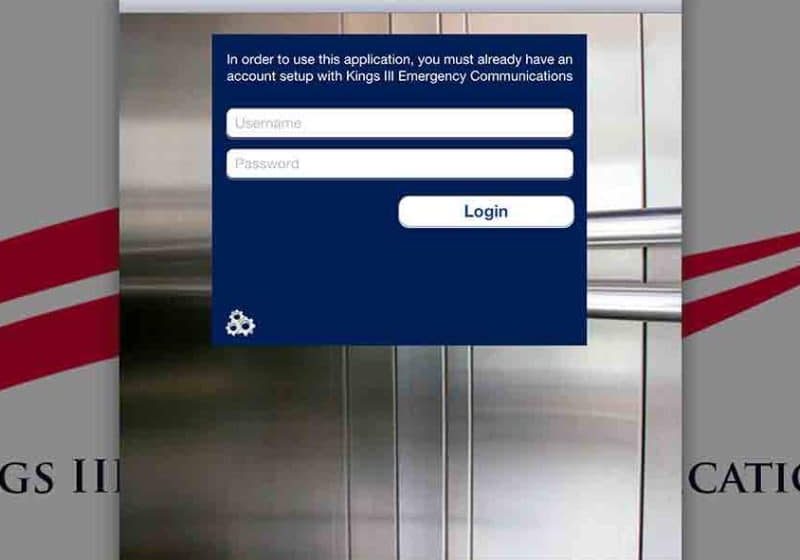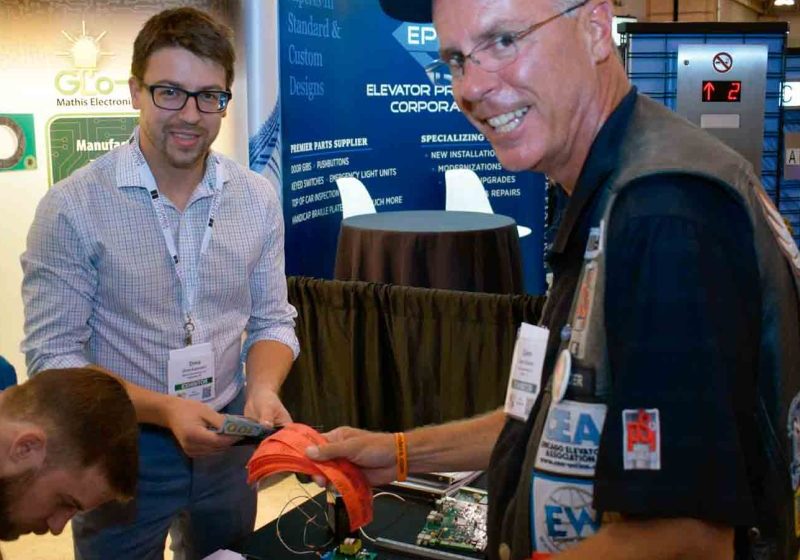Columbia: A Critical New Path to Customer Service
Dec 1, 2017

Cab, entrance, door and operator manufacturer shifts focus to clients’ needs.
On the cusp of a new year, Columbia Elevator Products Co. Inc. is emerging with an all-new mission: to operate with a customer-centric mindset and promote an overall culture built around best satisfying the concerns and needs of all its stakeholders (customers and employees alike).
“We have a heightened awareness of and focus on the human aspect of conducting business,” explained Columbia CEO Louis “L.J.” Blaiotta, Jr., continuing:
“Our business cannot solely be about the products. Sure, we at Columbia love our products, but our customers will never love them as much as we do. While we pride ourselves on our ‘pretty’ doors, for example, they don’t buy our doors simply because they’re prettier than the next company’s. With the given assumption that the product is of sufficient quality and safety compliance for the job, here’s what our customers, the installing elevator contractors, do deeply care about: getting the right solution, on time, every time. This means that they get from us exactly what they need, when they need it, packaged in a way that arrives safely, is complete and installs easily. In short, what they want is absolute reliance on a company that doesn’t give them ‘heartburn’ but makes them feel good about – and unhesitatingly confident in – their provider.”
With this newly defined vision of a customer’s needs, Columbia is undergoing a shift from a “products” company to a “customer service” company. To Columbia, this means more than simply providing exceptional customer service; it means aligning its systems, processes and people to think first about the customers and then to design around their wants and needs. According to Blaiotta, this is a companywide effort to entirely rearrange the way it does business. In addition to completely restructuring Columbia’s customer-facing divisions, which include Engineering, Customer Operations and Sales & Marketing, it is also rethinking methodologies and procedures in Operations and Quality Management.
Blaiotta said the objective is delighting customers with consistent, dependable jobsite peace of mind:
“We believe that having a ‘happy team’ deeply committed to these objectives is a major key to achieving them and have developed our own version of the virtuous spiral, called ‘Columbia’s Pay-it-Forward Culture.’ At the top, we have Columbia as the corporate entity, or the ‘solutions provider.’ Columbia must satisfy, or, better yet, make raving fans out of its employees and customers. To accomplish this, we strive to treat our employees, or team members, kindly and respectfully – with a genuine concern for their wellbeing – creating an environment that fosters a sense of pride, self-worth and fulfillment. By virtue of the way they are treated, we look to our team members to be inspired and empowered to ‘pay it forward’ to our customers, caring deeply about what they do and walking the proverbial extra mile. It is our hope, then, that the resulting exceptional experience for our customers will convert them into raving fans who continually strengthen the Columbia enterprise with the business they bring. A healthy Columbia can then increasingly invest in the well-being of its team, thereby continuing the cycle.”
Columbia’s revitalized commitment to its team members has led to the formal creation of an Employee Engagement division with two primary goals: to create an environment where team members love their jobs and continually invest in their growth. Over the last year, this division assembled a volunteer committee that has taken an active role in developing ways to recognize team member contributions, increase the use of two-way and transparent communication, and increase the sense of community and belonging throughout the organization. Company-sponsored quarterly events, monthly meetings and a continuing-education program are now all part of Columbia’s culture.
At the same time, Columbia’s commitment to customer satisfaction has prompted the company to reorganize the way it accepts orders. Previously, it separated orders into segments to be addressed by subject-matter experts in different departments, such as estimating/quotation, order acceptance/approval drawings, production/engineering and operations. When customers inquired during these different stages of production, the receptionist went through an arduous process to determine where the job was to connect the caller with the appropriate department. Now, each Columbia customer has an assigned account representative who intimately knows the status of each job and can provide quick, accurate answers to any query.
To ensure jobsite confidence and peace of mind for its customers, a key pillar in Columbia’s new strategy is to keep its contributions to construction projects off the so-called “critical path.” The Critical Path Method (CPM) originated in the 1950s as a project modeling technique for many fields, including construction. It was first used in a high-rise application in 1966 while developing the Twin Towers in New York City (NYC). CPM is a management tool used to define the shortest possible completion period for a project, with any delay of a critical path task delaying the entire project.
While competitive factors and maximized profitability often demand the quickest possible completion of a project, there are fixed limitations on how fast a building can be built. Certain aspects of the construction require lead and wait times that cannot be avoided. For example, it takes a certain amount of time for the concrete poured for a floor to dry before the next floor can be added and then again for that floor to dry before adding the next floor above it. Determining the shortest amount of time possible to construct a building involves taking all such critical items – the conditional pieces that cannot be started until a prior process is finished – and lining them up end-to-end to calculate the aggregate time required to complete the entire chain. Arriving at this measure of total time defines the critical path.
With the critical path for a project established, there are many functions that can be performed in parallel as the path rolls out. In construction, this is particularly true regarding installation of the elevators: how and when various stages of the installation are executed – ahead of or in harmony with critical path milestones – without being integral steps on which any other items on the path depend. According to Blaiotta, this is what Columbia endeavors to do for every job; that is, to always deliver its products for installation precisely when needed (or earlier) to prevent its contractor clients from ever becoming an obstacle on the path that would delay the entire building.
Continued Blaiotta:
“Unfortunately, sometimes our contractor customers get placed on or near the Critical Path through no fault of their own. This is because their clients, (building owners and developers) have so many early-stage areas of concern on the construction site. Initial priorities are items such as the foundation, plumbing and others that need to be addressed before the building can even start to go up. Next come architectural items, such as the exterior of the building and the lobby. Elevators are typically slated for late-stage delivery, often with the building more than halfway up before the elevator people are allowed onsite. Counter to this, until there are running, code-compliant elevators, the building’s certificate of occupancy (CO) – one of the project’s most critical and time-sensitive items – cannot be issued.”
Columbia’s customers, the installing elevator contractors, never want theirs to be the one mechanical system in the building that causes a delay in its opening, thereby exposing them to liability for liquidation damages, a slew of penalties and a ding on their reputation. Because it takes weeks to manufacture the products and ship them to the building site, the solution would appear to be for contractors to simply place their orders earlier. However, this often is not possible. The contractors get “squeezed” in the middle because, at that point, the developers have not yet given them the final direction and approvals for how they want the job to look. Consequently, with today’s modern construction techniques (and buildings often being topped off quicker than ever), the elevators have become needed in less than the minimum lead time traditionally required for them to be fabricated and delivered.
Continued Blaiotta:
“This is quite the conundrum, and here’s where Columbia has jumped in to help the contractors out of this jam. We can’t just be cavalier and demand they give us their orders earlier, since they’re already getting the specifications to us as soon as they can, but neither are they able to live with the traditional lead times. So, this marketplace reality led to a hard rethink: how do we keep our contractor customers off the critical path, by not only manufacturing their orders quicker, but also delivering them faster than before?
“The beginning of this new direction was our innovation of sequentially staging deliveries for high-rise construction, with roughs first, then jambs, then cabs, and finally interiors, but, recently, we discovered that this could apply equally as well to low rise. Before, we looked at low rise in relatively small terms. The cost to ship the products to the jobsite was such a large percentage of the low-rise contract that shipping the entire order only when completely ready made sense, and shipping it in increments did not. But, then we had an ‘A-ha!’ moment that changed our thinking!
“We realized that, when we have contractor customers on critical path jobs, it would make sense for us to send them the roughs at the stage of putting up the rails. If the contractors run up against a hiccup with the rails, they could start putting in the roughs. Next, we can ship the jambs with the cab shells, so they can hang the jambs and start installing the door operators in the cabs and so on, all to make it easier for them. The next thing you know, they’re running those cars, using them as construction lifts, and the building is getting its CO. Later, we can build the interiors, using our XChangaCab® program originally designed some years ago for modernizations and now adapted to this rethought process for new construction. There are customers who do high-rise work with us, and part of their projects may be low rise. The project could include a parking structure or garage, where the elevator is hydraulic, going up only a few floors, and the customer asks, ‘Can we get the staged delivery like we get from you for the high rise?’ And we say, ‘Sure, we can deliver the low-rise elevators using the same staged delivery we used on the high-rise elevators.’”
Additionally, in alignment with the various phases of product shipment, the approvals can also now be divided into two separate processes: structural, then aesthetic. This allows the building developers to operate the elevators as shells throughout the course of construction without having to make decisions regarding the interiors until much later. In the structural phase, approvals are for the size of the opening, height and door speed. With this information in hand, Columbia can ship structural components, with the hangers and track, for assembly. Then, when the developers determine the wall thicknesses, Columbia can send finished frames with the doors and the unadorned cab shells, including LED lighting already built in.
There are many labor- and time-saving nuances integral to this process, as detailed by Blaiotta:
“Because we know in advance that the hanging panels will be installed later, we can pre-punch the shells, with hanging louvers built into them, so that contractors do not need to apply hooks in the field to hang the panels. When we later send the hanging panels, they interface seamlessly with the perforations already in the cab shells. While we do not yet know what the panels will look like, all the louvered shells are, in effect, pre-templated with a perforation pattern that will work with any combination of hanging panels. There are several benefits to this process: no hole is greater than 3/8 in. (to meet code and allow for a running elevator), the job doesn’t get held up, the contractor has certainty that the cab interiors will fit, and the risk of damage to the decorative panels during installation and tenant move-in is alleviated.
“To further compress the timeframe, we now also stock the pre-punched cab shell panels on our shelves, rather than making them to order. So, if the contractor specifies a 72- or 84-in.-wide platform, we already have these in stock, built to handle a 2100-lb. car. If they need a 2500-lb. car (or any incremental weight up to 5000 lb.), we can quickly add some filler panels to accommodate the exact cab size needed. The car fronts ship in separate crates, left- or right-hand, as specified, with the door operators already mounted in the transom. Since these items are standard and not subject to an approval process, we can send these immediately upon order. While the architect is in the process of approving the interiors, the contractor can be installing the elevator system, including the cab enclosure, without having to wait. We have successfully tested this process with one of our major customers, who had started rolling it out to the industry at large.”
Blaiotta stated that, ultimately, it is all about giving Columbia’s contractor customers the best possible time and cost efficiencies for their installations, and analogizes the process to the purchase of a tailor-made suit: part bulk fabricated and part customized. Just as such garments are mass produced to standard waist sizes and then detailed for customer preferences such as length and cuff style, this approach enables Columbia to build its products in bulk, rather than one elevator at a time, which helps to get costs down, provide more customization and, most importantly, deliver much faster.
The most recent addition to the Columbia line to help keep customers off the critical path is the new QuikEnt 3 (QE3). There have been many versions of standard-sill-depth entrances and narrow-sill entrances over the years, each designed to be compatible with one of the various available door operators. With QE3, Columbia’s objective was to develop standard types of strut/sill support and hanger assemblies that could work with any door operator and hanger equipment. Traditionally, while the struts were standard on every type of entrance, a contractor needed to select which type of sill support angle to get, dependent on whether the installation was going into a haunch (concrete pocket), with a general-contractor-provided structural sill support angle, floating sill support angle, or C3 commercial angle.
Blaiotta said:
“All of these scenarios are provided for in the new QE3. In the past, we’ve offered different entrance types for different situations, changing the entire entrance every time. Now the jamb, door and strut we make are the same every time, regardless of the hanger and sill support angle, because, with QE3, we’re using the same strut, header and bent mounting location all the time, and only changing out the type of sill support and the drilling pattern to mount the door tracks onto the headers. This makes for very quick work by the installers, who don’t have to repeatedly learn a new entrance every time and instead can simply customize it depending on the type of track being provided and/or the loading requirement, which drives the type of sill support angle. The header mounting location is the same every time, but the shape of the header might be slightly different to handle nonproprietary and different OEMs’ hanger requirements.”
Blaiotta emphasized that new products and services do not mean much if they are not part of a solution. Technological and economic changes outside the elevator industry are strong influencers, as is the growing societal emphasis on efficiency. There are increasingly more jobs being done with fewer people. Sometimes, especially in construction, this can lead to unintended consequences and new approaches required to react to them. Blaiotta, as an example, cited that technological advancements are allowing for high-speed concrete pouring, which, while a positive in one way, sacrifices accuracy. He explains that, in earlier days, a great deal of care was devoted to exactly where the edge of the slab would be, because the angle that would support the elevator sill was mounted to that slab, with reliance on it being absolutely level and straight. This made for easy and precise entrance installation but was ended by the irregular slabs resulting from the new pouring methods.
Blaiotta continued:
“Our reaction to this problem was to develop a tower entrance, a self-supporting structure that does not rely on the accuracy of the slab on every floor, but actually carries the load from the pit to the openings. It’s like a series of rails that are, in effect, a ladder. As a further innovative reaction to this problem, we now have a new structural part called a ‘slab correction angle.’ This is mounted on the edge of an imperfect slab and adjusts so it can close the gap between an imperfect slab and a perfectly aligned tower. Instead of having to wait for the structural trades to build a perfect landing on which to put our sill, we now are positioning our sill where it needs to be, relative to the moving platform. No matter how inaccurate the slab, we can install a correction plate or angle that has telescopic abilities to adapt to it. This provides freedom to the elevator contractor, which no longer needs to wait for another trade. It also eliminates the finesse previously needed to adjust to every floor, which, in turn, speeds up the erection of the tower. We came up with all of this because someone outside our industry developed a way to pour concrete more quickly – something we might never have thought of if this hadn’t happened.
“Another example was when we recently developed our car-side interlock for glass-backed cars at the Los Angeles International Airport (LAX) to lock passengers safely in the car while eliminating the conventional, unsightly fascia in the hoistway (ELEVATOR WORLD, August 2017). This was not just some experiment, but, instead, completely customer-need and marketplace driven. A further evolution resulting from a specific need at LAX regarded a two-floor situation, where they had one ground-level opening at the front of the car and another opening on the upper floor at the rear of the car.
“With our partners at Spain-based Fermator, we came up with an operator that had a control box with its own built-in programming tool. Plus, because of differing access issues on the two floors, we relocated the car-operator controller so that, instead of being fixed-mounted to the front of the operator, it is tethered at the top of the car to the operator in a way that enables it to be turned into different positions for accessibility from multiple directions.
“With the old linear door-operator configuration, the controller was mounted inside the face of the operator facing forward, just above the doors. A mechanic would have to disengage the car doors from the landing doors, then lower the cab down a few feet below the landing to gain access to the controller, all while standing on the landing, to adjust the speed of the doors. The mechanic would then guess at the new, desired door close time (either slower or faster) and set the door speed accordingly. However, the mechanic wouldn’t know if the correct adjustment had been made until the car doors were recoupled with the hatch doors, and the resulting pair of doors would operate together, at the same time. If the wrong speed were entered, this process would continue on a trial-and-error basis until the desired speed was finally achieved. This was not an efficient process. Now, this most recent version of the operator allows the mechanic to stay in a safe place and adjust the door-open and -close times, while the car and hatch doors are engaged. This is a breakthrough for a linear operator environment. It goes out preinstalled in the transom so the installers also save the time of having to do this in the field.”
Columbia also recognized a demand in the marketplace for faster-moving doors. To address the laws of kinetic energy, which would require more (and, in this case, too much) force to open and close the heavy doors quicker, Columbia’s solution was to reduce their mass by eliminating their back skin. In earlier days, when harmonic operators were the standard, the clutch was attached to the back of the door, which required the back skin as a mounting surface. But, with Columbia’s linear operator that relocates the clutch to the top of the door and the pickup rollers to the hanger assembly, the back skin can effectively be excluded. This single-skin door, with no welding on its face, is flatter, looks much smoother, weighs much less and, therefore, can move much faster without violating any of the kinetic-energy rules.
While this new door has become very popular, there remains an ample amount of existing product in the field that uses harmonic operators, which still require that the clutch and pickup rollers be mounted on the back of the door. Columbia has further adapted its single-skin door by placing a small plate, large enough only to accommodate the mounting of the clutch, on its back. This recent innovation enables lighter, faster-moving, harmonically operated doors.
Another marketplace demand, especially for modernizations, concerned the ability for a small hoistway to accommodate a larger entrance. For Americans With Disabilities Act (ADA) compliance, a car interior needs to be a certain depth and width. Since there is no practical way to enlarge a hoistway for compliance, the only alternative is a way to create more space inside the car. Columbia’s initial solution, several years ago, was to push the entrance inside the wall to eliminate swing doors. But, in “virtual new construction” – modernizations so comprehensive that the elevator is almost entirely new – the order of the day is for fully operational sliding doors and elimination of the stationary panels and transoms that were integral to in-wall installations.
Columbia’s challenge was to make the entrance and door-operating equipment as narrow as possible to occupy the minimum possible amount of space in the hoistway. While Columbia continues to make its classic-depth sill for use with legacy harmonic-operator installations, with the elimination of the clutch and rollers from the back of the door (enabled by its linear operator), the doors can be moved much closer to the running clearance edge of the sill, thereby simultaneously enlarging the platform and the corresponding cab interior.
Blaiotta explained:
“For a single-speed door, we were able to have a 2-1/4-in. sill, instead of 4 in. on both the hatch and platform, picking up 3-1/2 in. of shaft space, while, for a two-speed door, it was 3-1/2 in. instead of 5-1/2 in., picking up an additional 4 in. between the cab and landing sills. Building upon that innovation, we now have two types of entrances: one for traditional, standard depth, and one we’re calling ‘slim-line.’ We’ve partnered once again with Fermator to build a slim-line hanger assembly called ‘Premium.’ This allows the cab platform to be a couple of inches deeper — to meet the ADA requirement without making the hoistway bigger.”
Bottom line: Columbia is strategically innovating in response to the needs of and influences on today’s construction jobsite, rather than simply releasing a series of new products merely for the sake of it. Blaiotta concluded, “We’re increasingly focusing on the ‘people’ side of the equation.”
Get more of Elevator World. Sign up for our free e-newsletter.









